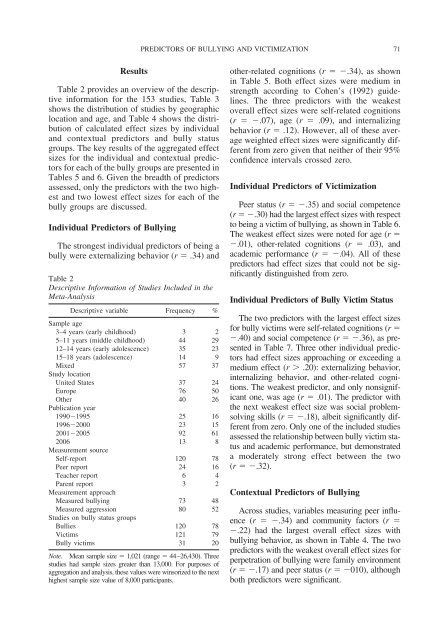Predictors of Bullying and Victimization in Childhood and Adolescence
Predictors of Bullying and Victimization in Childhood and Adolescence
Predictors of Bullying and Victimization in Childhood and Adolescence
Create successful ePaper yourself
Turn your PDF publications into a flip-book with our unique Google optimized e-Paper software.
Results<br />
Table 2 provides an overview <strong>of</strong> the descriptive<br />
<strong>in</strong>formation for the 153 studies, Table 3<br />
shows the distribution <strong>of</strong> studies by geographic<br />
location <strong>and</strong> age, <strong>and</strong> Table 4 shows the distribution<br />
<strong>of</strong> calculated effect sizes by <strong>in</strong>dividual<br />
<strong>and</strong> contextual predictors <strong>and</strong> bully status<br />
groups. The key results <strong>of</strong> the aggregated effect<br />
sizes for the <strong>in</strong>dividual <strong>and</strong> contextual predictors<br />
for each <strong>of</strong> the bully groups are presented <strong>in</strong><br />
Tables 5 <strong>and</strong> 6. Given the breadth <strong>of</strong> predictors<br />
assessed, only the predictors with the two highest<br />
<strong>and</strong> two lowest effect sizes for each <strong>of</strong> the<br />
bully groups are discussed.<br />
Individual <strong>Predictors</strong> <strong>of</strong> <strong>Bully<strong>in</strong>g</strong><br />
The strongest <strong>in</strong>dividual predictors <strong>of</strong> be<strong>in</strong>g a<br />
bully were externaliz<strong>in</strong>g behavior (r .34) <strong>and</strong><br />
Table 2<br />
Descriptive Information <strong>of</strong> Studies Included <strong>in</strong> the<br />
Meta-Analysis<br />
Descriptive variable<br />
Sample age<br />
Frequency %<br />
3–4 years (early childhood) 3 2<br />
5–11 years (middle childhood) 44 29<br />
12–14 years (early adolescence) 35 23<br />
15–18 years (adolescence) 14 9<br />
Mixed<br />
Study location<br />
57 37<br />
United States 37 24<br />
Europe 76 50<br />
Other<br />
Publication year<br />
40 26<br />
19901995 25 16<br />
19962000 23 15<br />
20012005 92 61<br />
2006<br />
Measurement source<br />
13 8<br />
Self-report 120 78<br />
Peer report 24 16<br />
Teacher report 6 4<br />
Parent report<br />
Measurement approach<br />
3 2<br />
Measured bully<strong>in</strong>g 73 48<br />
Measured aggression<br />
Studies on bully status groups<br />
80 52<br />
Bullies 120 78<br />
Victims 121 79<br />
Bully victims 31 20<br />
Note. Mean sample size 1,021 (range 44–26,430). Three<br />
studies had sample sizes greater than 13,000. For purposes <strong>of</strong><br />
aggregation <strong>and</strong> analysis, these values were w<strong>in</strong>sorized to the next<br />
highest sample size value <strong>of</strong> 8,000 participants.<br />
PREDICTORS OF BULLYING AND VICTIMIZATION<br />
other-related cognitions (r .34), as shown<br />
<strong>in</strong> Table 5. Both effect sizes were medium <strong>in</strong><br />
strength accord<strong>in</strong>g to Cohen’s (1992) guidel<strong>in</strong>es.<br />
The three predictors with the weakest<br />
overall effect sizes were self-related cognitions<br />
(r .07), age (r .09), <strong>and</strong> <strong>in</strong>ternaliz<strong>in</strong>g<br />
behavior (r .12). However, all <strong>of</strong> these average<br />
weighted effect sizes were significantly different<br />
from zero given that neither <strong>of</strong> their 95%<br />
confidence <strong>in</strong>tervals crossed zero.<br />
Individual <strong>Predictors</strong> <strong>of</strong> <strong>Victimization</strong><br />
Peer status (r .35) <strong>and</strong> social competence<br />
(r .30) had the largest effect sizes with respect<br />
to be<strong>in</strong>g a victim <strong>of</strong> bully<strong>in</strong>g, as shown <strong>in</strong> Table 6.<br />
The weakest effect sizes were noted for age (r <br />
.01), other-related cognitions (r .03), <strong>and</strong><br />
academic performance (r .04). All <strong>of</strong> these<br />
predictors had effect sizes that could not be significantly<br />
dist<strong>in</strong>guished from zero.<br />
Individual <strong>Predictors</strong> <strong>of</strong> Bully Victim Status<br />
The two predictors with the largest effect sizes<br />
for bully victims were self-related cognitions (r <br />
.40) <strong>and</strong> social competence (r .36), as presented<br />
<strong>in</strong> Table 7. Three other <strong>in</strong>dividual predictors<br />
had effect sizes approach<strong>in</strong>g or exceed<strong>in</strong>g a<br />
medium effect (r .20): externaliz<strong>in</strong>g behavior,<br />
<strong>in</strong>ternaliz<strong>in</strong>g behavior, <strong>and</strong> other-related cognitions.<br />
The weakest predictor, <strong>and</strong> only nonsignificant<br />
one, was age (r .01). The predictor with<br />
the next weakest effect size was social problemsolv<strong>in</strong>g<br />
skills (r .18), albeit significantly different<br />
from zero. Only one <strong>of</strong> the <strong>in</strong>cluded studies<br />
assessed the relationship between bully victim status<br />
<strong>and</strong> academic performance, but demonstrated<br />
a moderately strong effect between the two<br />
(r .32).<br />
Contextual <strong>Predictors</strong> <strong>of</strong> <strong>Bully<strong>in</strong>g</strong><br />
Across studies, variables measur<strong>in</strong>g peer <strong>in</strong>fluence<br />
(r .34) <strong>and</strong> community factors (r <br />
.22) had the largest overall effect sizes with<br />
bully<strong>in</strong>g behavior, as shown <strong>in</strong> Table 4. The two<br />
predictors with the weakest overall effect sizes for<br />
perpetration <strong>of</strong> bully<strong>in</strong>g were family environment<br />
(r .17) <strong>and</strong> peer status (r 010), although<br />
both predictors were significant.<br />
71
















